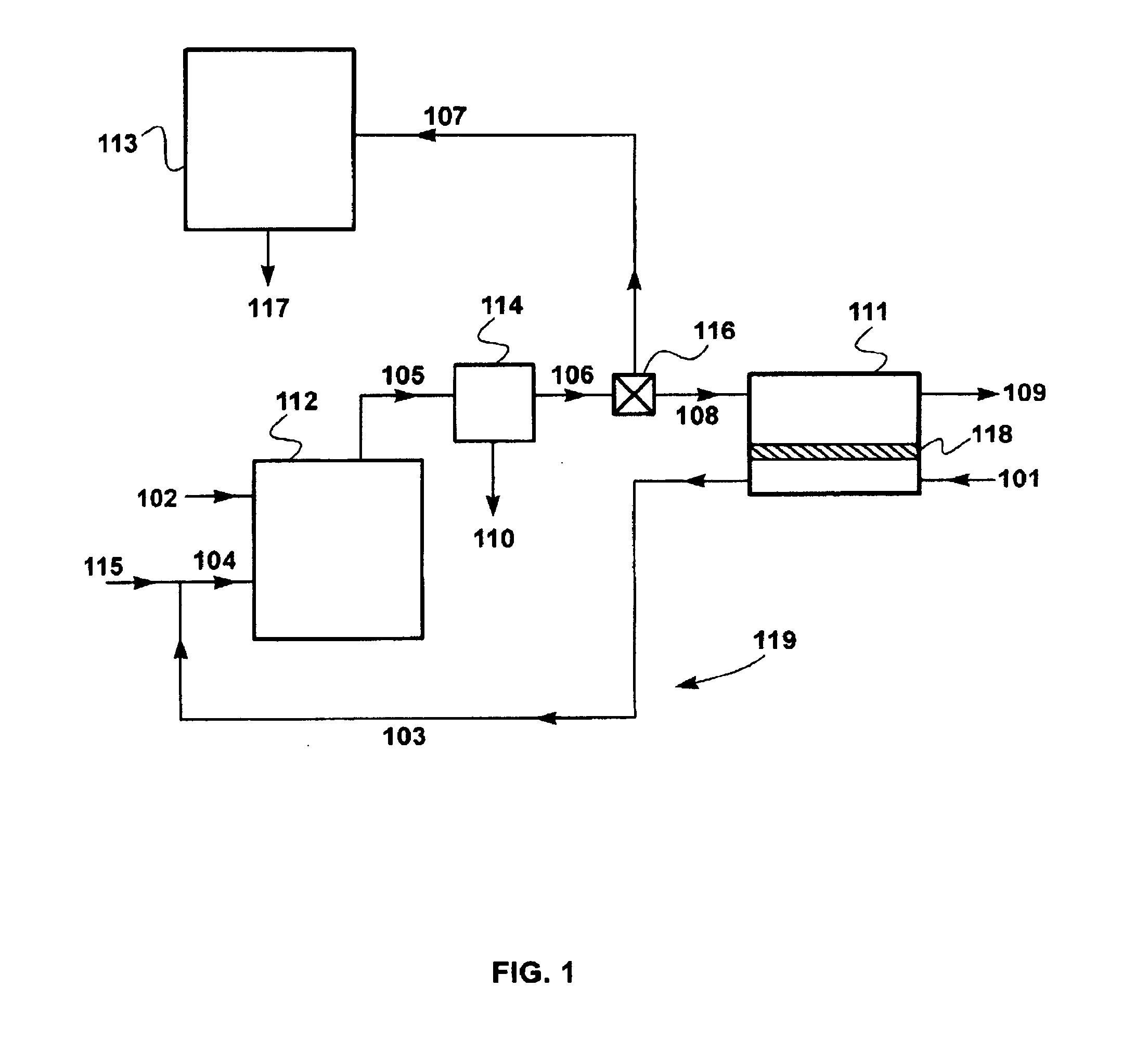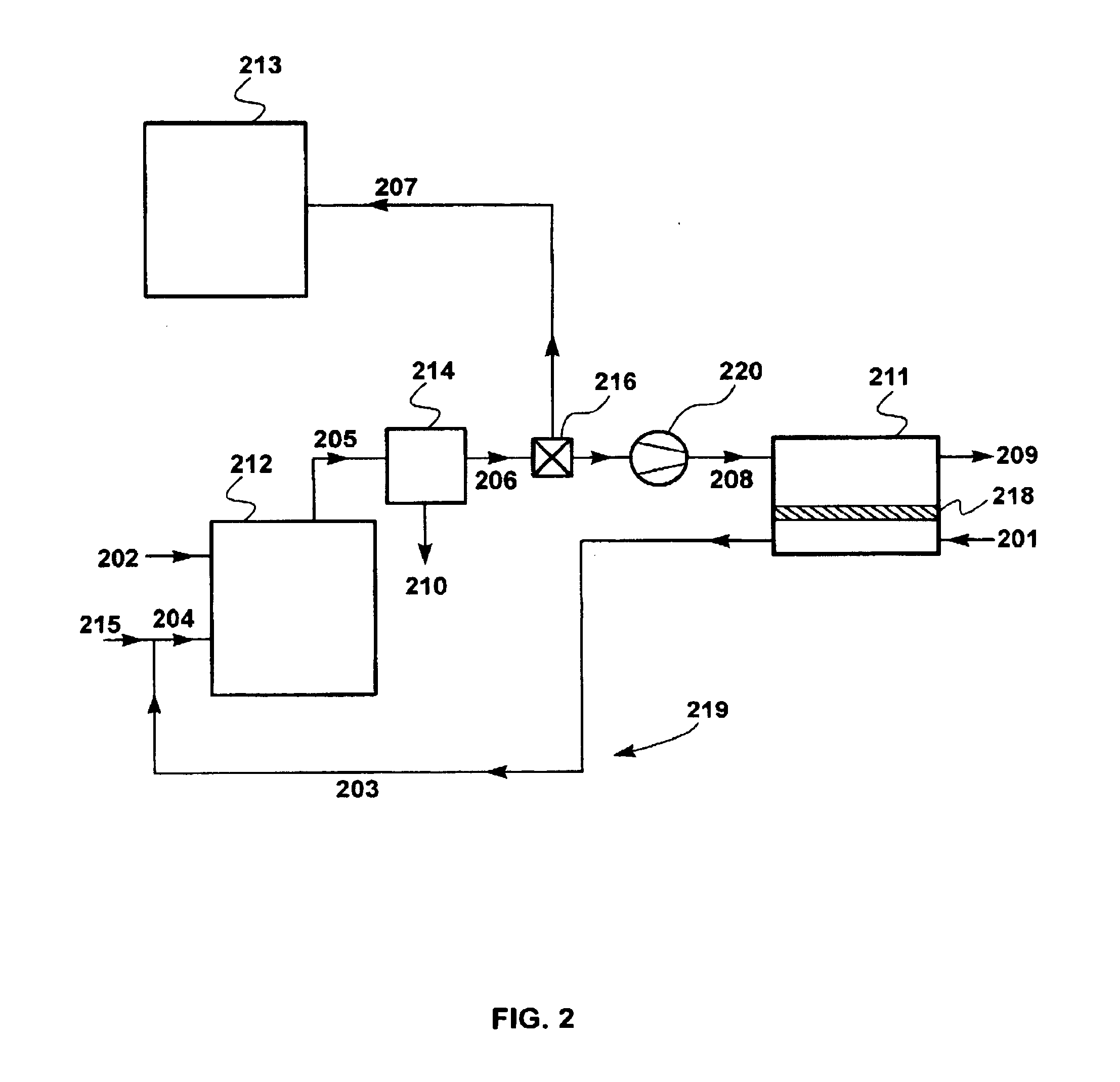Membrane loop process for separating carbon dioxide for use in gaseous form from flue gas
a technology of carbon dioxide and gaseous form, which is applied in the field of membrane-based gas separation process, can solve the problems of power plants producing enormous amounts of flue gas, and achieve the effects of enhancing oil recovery, reducing the potential contribution of global warming, and enhancing the recovery of coalbed methan
- Summary
- Abstract
- Description
- Claims
- Application Information
AI Technical Summary
Benefits of technology
Problems solved by technology
Method used
Image
Examples
example 1
Bases of Calculations for Other Examples
[0111](a) Membrane permeation experiments: The following calculations were performed using a composite membrane having a polyether-based selective layer with the properties shown in Table 1.
TABLE 1GasPermeance (gpu)*CO2 / Gas SelectivityCarbon dioxide1,000 —Nitrogen3033Oxygen6017Hydrogen100 10Carbon 11,000Water5,000** —*Gas permeation unit; 1 gpu = 1 × 10−6 cm3(STP) / cm2 · s · cmHg**Estimated, not measured
[0112](b) Calculation methodology: All calculations were performed using a modeling program, ChemCad 5.6 (ChemStations, Inc., Houston, Tex.), containing code for the membrane operation developed by MTR's engineering group. For the calculations, all compressors and vacuum pumps were assumed to be 75% efficient. In each case, the modeling calculation was performed to achieve 90% recovery of carbon dioxide from the flue gas stream.
[0113](c) “No membrane” example: A computer calculation was performed to determine the chemical composition of untreat...
examples 2-8
Processes of the Invention: Modeling of Sweep-Based Membrane Separation Step and Effect on Combustion Step
[0117]A set of calculations was performed to model the effect of various process parameters on the performance of the sweep-based membrane separation step and its effect on the combustion step. The calculations for Examples 2 through 8 were performed using the flow scheme shown in FIG. 1 and described in the Detailed Description, above. This flow scheme includes a sweep-based membrane separation step, 111.
[0118]To facilitate operation of the calculation software, the base case air flow provided to the combustor via the membrane permeate side was assumed to be about 740 m3 / h (950 kg / h), compared with the typical air flow to a 500 MW power plant of about 1.8 million m3 / h used for the calculation of Example 1. In other words, the scale of the calculations for Examples 2 through 8 was about 1 / 2,400 of the scale for a typical coal-fired power plant. This reduces membrane area proport...
example 2
Process of the Invention
[0119]In this example, the membrane area was assumed to be 400 m2, and the combustion exhaust stream split ratio was set at 1:1 (bleed flow of partially concentrate product gas:flow to sweep-based membrane separation step). The separation was assumed to be performed using a membrane having permeation properties as in Table 1. The results of this calculation are shown in Table 3.
TABLE 3StreamPartiallyCondenserConcentratedMembraneAirGas toCoalKnockoutProduct GasFeedSweepCombustorRetentate(102)(110)(107)(108)(101)(103)(109)ParameterTotal Flow (kg / h)55465545549501100404Temperature (° C.)25404040253325Pressure (bar)1.01.01.01.01.01.01.0Component (vol %)Coal (carbon +100000000hydrogen)Oxygen001.61.621.017.55.2Nitrogen0071.871.879.070.691.9Carbon Dioxide0019.219.208.32.9Water01007.47.403.60
[0120]Compared with the “no membrane” Example 1, the carbon dioxide content in the combustion exhaust stream (membrane feed), 108, and the partially concentrated product gas, 107,...
PUM
 Login to View More
Login to View More Abstract
Description
Claims
Application Information
 Login to View More
Login to View More - R&D
- Intellectual Property
- Life Sciences
- Materials
- Tech Scout
- Unparalleled Data Quality
- Higher Quality Content
- 60% Fewer Hallucinations
Browse by: Latest US Patents, China's latest patents, Technical Efficacy Thesaurus, Application Domain, Technology Topic, Popular Technical Reports.
© 2025 PatSnap. All rights reserved.Legal|Privacy policy|Modern Slavery Act Transparency Statement|Sitemap|About US| Contact US: help@patsnap.com



